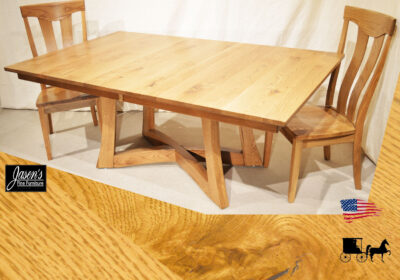Amish Furniture Finish

Amish furniture is the sum of its parts. In other words, the end product is a culmination of a chosen North American hardwood straight from the forest (consisting of multiple appealing choices like oak, maple, and cherry, hickory, walnut and elm, to simply name a few), along with countless hours of sweat equity from the efforts of the Amish craftsmen responsible for having the vision and the talent to turn humble pieces of wood into furnishings considered by many owners to be pieces of art suitable for display in the finest galleries across the country.
But there is far more than a collection of carved wood pieces involved in the completion of these Amish furniture pieces that have earned a reputation for excellence from generations of owners. At the end of the day, the finished Amish furniture products depend on, well, Amish furniture finishes to be considered truly complete. Those finishes might consist of stains, varnishes and paints to name a few – and regardless of the selection, each coating is providing a level of protection from the natural wear and tear from routine use, helping guarantee the longevity of a product for the long term.
The reason for any finish is simple. Accidents happen. If a beverage – be it a glass of wine or a soft drink – is in hand, chances are an inadvertent spill will take place sooner or later. Untreated wood lacking a suitable finish will probably suffer the ill effects from careless drink handling, with the after-effects lasting for the lifetime of the piece. Who wants to look back a decade later at an unsightly stain on a piece of furniture, all because of one moment of carelessness? Expertly chosen and properly applied finishes will provide a layer of protection separating the liquid from the wood, ultimately protecting the surface of the wood from unsightly stains.
Similarly, simply imagine a rambunctious four-year-old that has managed to find his mother’s car keys, concealed in the depths of his mom’s purse. As any parent can attest, there is a good chance those car keys will inadvertently end up deeply marring a beloved piece of furniture when a child accidently keys the piece of furniture. Even the most vigilant parent might not be able to act quickly enough to prevent a key from scratching the solid maple kitchen table in question. However, a properly applied varnish improves the hardness of the wood, potentially protecting the surface of the wood and entirely avoiding undesirable scratches.
In essence, finishes represent the final step in a complex crafting process starting when the artisan selects the piece of wood to be used in crafting a particular piece and successfully concluding when the sealants are carefully and expertly applied on all exposed surfaces. The entire process doesn’t come to a satisfactory close until the finished product is sealed in a protective sealant. It’s far more than mere cosmetic appearance, although in truth an expertly applied finish can enhance the richness of an already visually striking piece.


